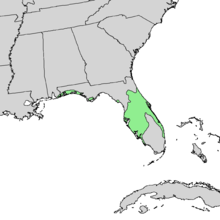| Pinus clausa | |
|---|---|

| |
| Conservation status | |
 Least Concern (IUCN 3.1) | |
| Scientific classification | |
| Kingdom: | Plantae |
| Clade: | Tracheophytes |
| Clade: | Gymnospermae |
| Division: | Pinophyta |
| Class: | Pinopsida |
| Order: | Pinales |
| Family: | Pinaceae |
| Genus: | Pinus |
| Subgenus: | P. subg. Pinus |
| Section: | P. sect. Trifoliae |
| Subsection: | P. subsect. Contortae |
| Species: | P. clausa |
| Binomial name | |
| Pinus clausa (Chapm. ex Engelm.) Sarg. | |

| |
| Generalized natural range of Pinus clausa | |
Pinus clausa is a species of pine endemic to the Southeastern United States. Its common names include sand pine, Florida spruce pine, and scrub pine.
Distribution
The tree is found in two separate locations, one across central peninsular Florida, and the other along the western Florida panhandle coast into the Alabama coast. There is a range gap of about 200 km (120 mi) between the populations (from the Ochlockonee River to Cedar Key). The sand pines of the Florida peninsula and of the Florida panhandle coast differ enough to be classified into two varieties or races, Pinus clausa var. clausa ("Ocala"), on the peninsula, and P. clausa var. immuginata ("Choctawhatchee"), along the panhandle coast. While most peninsular sand pines (var. clausa) have non-serotinous, or open, cones, most of the panhandle sand pines (var. immuginata) have serotinous, or closed, cones.
Sand pine is largely confined to the very infertile, excessively well-drained, sandy habitat of Florida scrub. It is often the only canopy tree in the Florida scrub ecosystem. Stands of sand pines in peninsular Florida tend to be dense and of the same age, while stands of sand pines along the panhandle coast tend to be more open than on the peninsula, and with trees of varying age.
Description
Pinus clausa is a small, often shrubby tree from 5–10 m (16–33 ft), exceptionally to 21 m (69 ft) tall. It is vulnerable to windfall, and stands in areas prone to hurricanes can be found leaning in the same direction.
The leaves are needle-like, in pairs, 5–10 cm (2.0–3.9 in) long, and its cones are 3–8 cm (1.2–3.1 in) long.
Over much of its range, it is fire-adapted to stand-replacing wildfires, with the cones remaining closed for many years (clausa = closed), until a natural forest fire kills the mature trees and opens the cones. These then reseed the burnt ground. Some populations differ in having cones that open at maturity, with seed dispersal not relying on fires. Without a fire every 20-60 years, Pinus clausa populations will be succeeded by oak and hickory. Most fires occur in the spring due to low water content in the needles and high winds. In addition, resin content is highest in the spring, causing extreme or uncontrollable fire behavior, such as a 1935 fire in Ocala National Forest that burned 5,670 acres (2,295 ha) in only 4 hours.

Uses
Pinus clausa woodlands are an important part of the Florida scrub ecosystem, and provide habitat for songbirds, birds of prey, grey and flying squirrels, as well as the endangered Florida sand skink and Florida scrub jay, among other species. It is one of the few canopy trees able to grow in arid, sandy, and hot locations with minimal care.
While the dense branching and crooked trunks makes this tree unsuitable for wood production, it is often used for wood pulp.
References
- ^ Farjon, A. (2013). "Pinus clausa". IUCN Red List of Threatened Species. 2013: e.T34050A2841499. doi:10.2305/IUCN.UK.2013-1.RLTS.T34050A2841499.en. Retrieved 19 November 2021.
- "Pinus clausa". Germplasm Resources Information Network. Agricultural Research Service, United States Department of Agriculture. Retrieved 20 December 2017.
- Myers, Roland L. (1990). "Scrub and High Pine". In Myers, Ronald L.; Ewel, John J. (eds.). Ecosystems of Florida. Orlando, Florida: University of Central Florida Press. pp. 162–163. ISBN 0-8130-1022-5.
- Brendemuehl 1990, p. 294.
- Brendemuehl 1990, pp. 294–295.
- ^ Carey, Jennifer H. (1992). "Species: Pinus clausa". Fire Effects Information System. Retrieved 30 May 2024.
- Earle, Christopher J. (3 March 2023). "Pinus clausa (sand pine) description". The Gymnosperm Database. Retrieved 30 May 2023.
- ^ "Pinus clausa in Flora of North America @ efloras.org". www.efloras.org.
- Moore, Gerry; Kershner, Bruce; Craig Tufts; Daniel Mathews; Gil Nelson; Spellenberg, Richard; Thieret, John W.; Terry Purinton; Block, Andrew (2008). National Wildlife Federation Field Guide to Trees of North America. New York: Sterling. p. 70. ISBN 978-1-4027-3875-3.
- Myers, Ronald L.; Ewel, John J., eds. (1991). Ecosystems of Florida (2. printing ed.). Orlando: University of Central Florida Press. ISBN 978-0-8130-1022-9.
Sources
- Brendemuehl, R. H. (1990). "Pinus clausa Sand Pine". In Burns, Russell M.; Honkala, Barbara H. (eds.). Silvics of North America: Volume 1, Conifers. Agriculture Handbook 654. Washington, D.C.: Forest Service, United States Department of Agriculture. pp. 294–301. ISBN 978-0-16-027145-8. LCCN 86-600518.
External links
- Pinus clausa. USDA PLANTS.
- Pinus clausa. Flora of North America.
| Taxon identifiers | |
|---|---|
| Pinus clausa |
|
| Pinus inops var. clausa | |